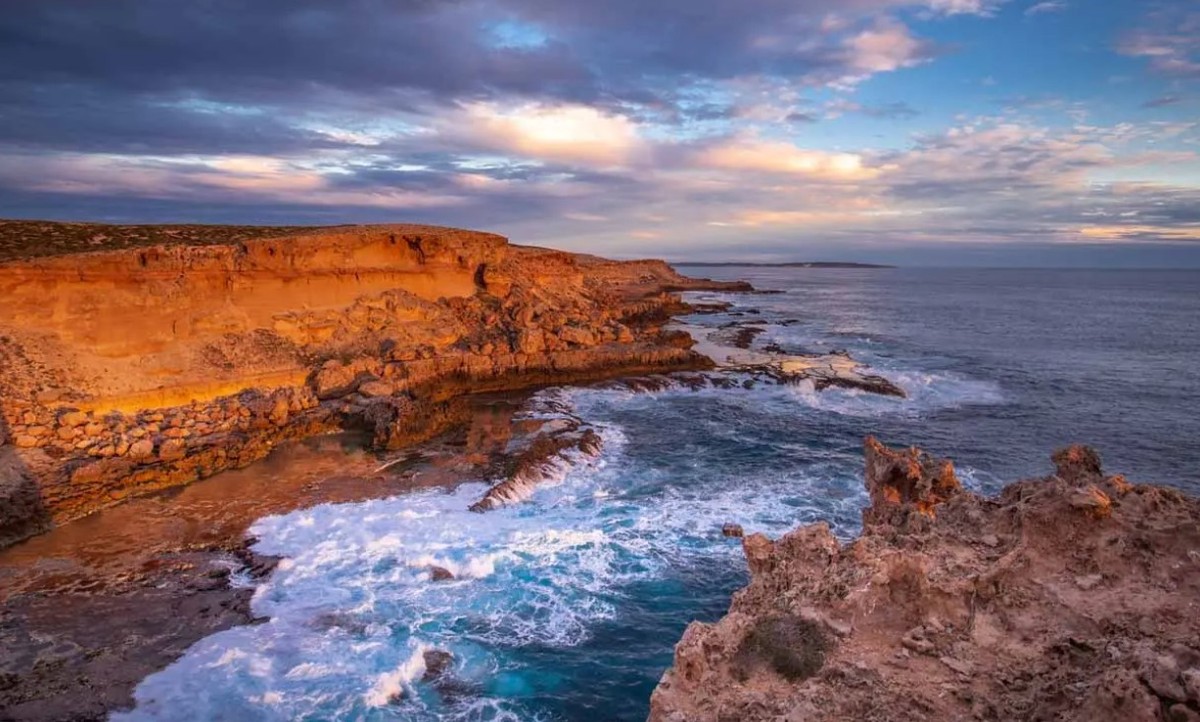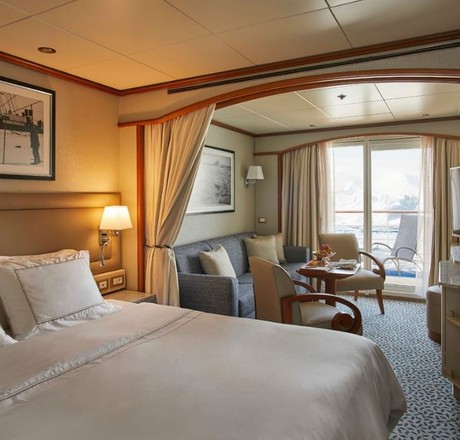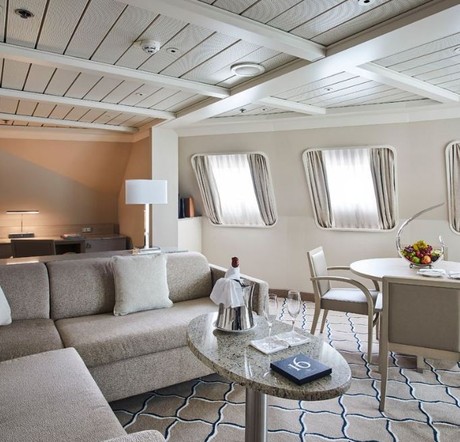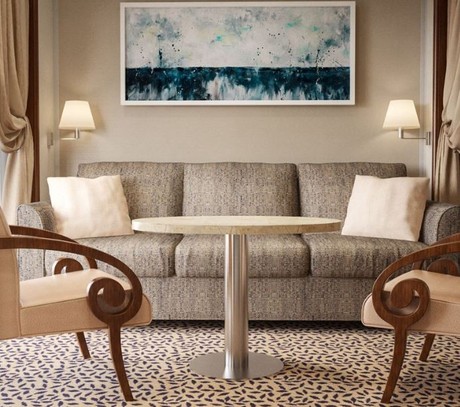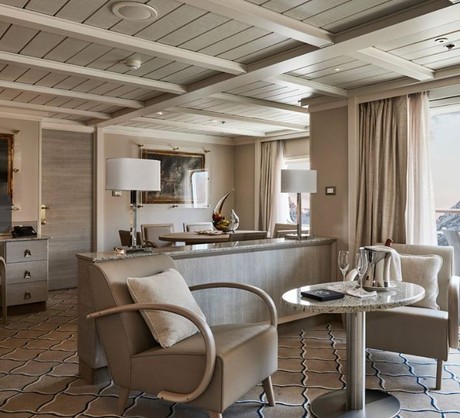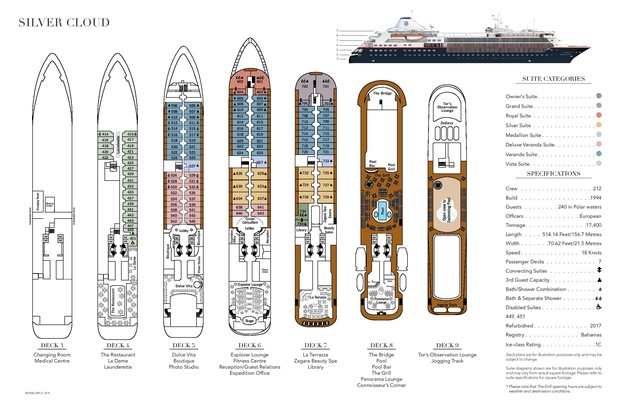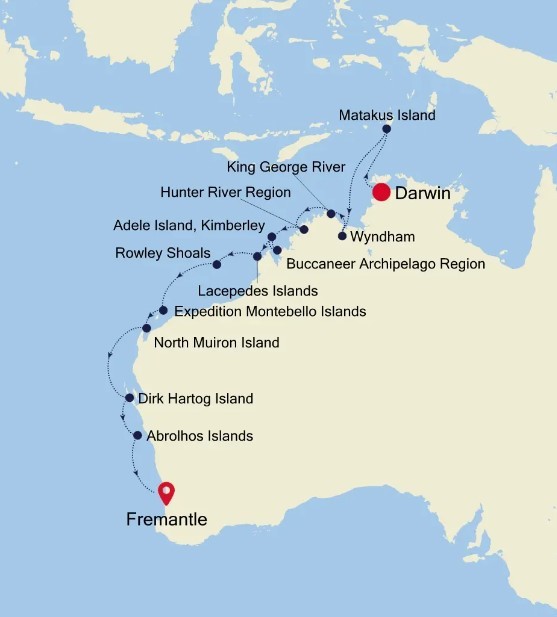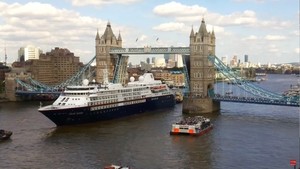show reverse itinerary
Day 2 Darwin AUSTRALIA
"Australia's capital of the north is a uniquely tropical city, and a historically isolated outpost of this vast, diverse country. Reaching up towards the equator, a full 2,000 miles from Sydney and Melbourne, the city was named in honour of Charles Darwin by the British settlers who established a frontier outpost here. With a unique history, beautiful islands nearby, and a palette of sizzling Pacific flavours, colourful Darwin is an enchanting and exotic Australian destination. Crocodiles patrol the jungled waterways and tropical rainforests around Australia's gateway to the Top End. Explore via airboat to look down on the veiny waterways of the mist-laced Kakadu National Park. The sounds of chattering birdlife and the gentle splash of fountains and waterfalls will fill your ears in George Brown Darwin Botanic Gardens. Soak it all in, before kicking back and relaxing with a picnic and a crackling barbecue. The sunshine and famous tropical pink sunsets mean many visitors naturally gravitate to the city's soft sands to relax at spots like pretty Mindil Beach, as evening approaches. The adjoining market is filled with souvenirs and crafts stands and is the perfect great place to enjoy some fiery Asian flavours. Stroll the stalls, grab some food, and crack open an ice-frosted beer as the sunset show begins. It may be remote, but Darwin found itself on the front line during the Pacific War, as the Japanese air force unloaded their bombs onto the city in 1942. This relaxed unassuming city has a deeply resilient backbone, however, and you can explore the museums to learn more of the war's impact on Darwin, as well as the devastating effects of one of Australia's worst natural disasters, Cyclone Tracy in 1973."
Day 3 Day at sea INTERNATIONAL WATERS
Days at sea are the perfect opportunity to relax, unwind and catch up with what you’ve been meaning to do. So whether that is going to the gym, visiting the spa, whale watching, catching up on your reading or simply topping up your tan, these blue sea days are the perfect balance to busy days spent exploring shore side.
Day 4 Matakus Island INDONESIA
The eastern part of Indonesia is a true paradise on Earth. Home to countless beautiful, unexplored destinations that have not enjoyed the tourism boom that many other parts of the country have. Matakus Island is one such destination. This makes it a perfect place for those who have a sense of adventure and truly want to explore off the beaten path. Matakus is a small island and part of the Tanimbar archipelago. At just over two miles in length and less than a mile across, it is one of the smaller islands but, despite its small size, its proximity to the regional capital city of Saumlaki just to the north ensures that the island is inhabited (current population 100). The tourism infrastructure is practically inexistent, so don’t expect to be souvenir shopping here – ordering a lunch of delicious freshly caught and grilled fish from one of the local fishermen that line the shore is about the maximum! The island is surrounded by fine, white-sand beaches and is a marine paradise, with fields of staghorn coral and schools of cardinalfish visible in its crystal clear waters. Birds including the Tanimbar starling, Moluccan masked owl, Fawn-breasted thrush and Blue-streaked lorry all call the island home.
Day 5 Day at sea INTERNATIONAL WATERS
Days at sea are the perfect opportunity to relax, unwind and catch up with what you’ve been meaning to do. So whether that is going to the gym, visiting the spa, whale watching, catching up on your reading or simply topping up your tan, these blue sea days are the perfect balance to busy days spent exploring shore side.
Day 6 Wyndham AUSTRALIA
Wyndham is a small settlement with the spirit of a Kimberley outback township. It was established in 1886 with the Halls Creek gold rush and sits on the Cambridge Gulf where several rivers converge. Today Wyndham has a population of roughly 900 people and operates largely as a port exporting cattle, servicing the mining industry and hosting a few small ships. For these vessels Wyndham is a gateway to the nearby Ord River. Conversely, cruising the peaceful and tree-lined Ord River is a chance to look for freshwater crocodiles, fruit bats, short-eared rock wallabies and a variety of birds, including Mangrove Herons and Mangrove Gerygones. Please note: All destinations on voyages in the Kimberley region, and the order in which they are visited, are subject to tidal variations and weather conditions.
Day 7 King George River (Kimberley, Western Australia) AUSTRALIA
The King George Falls is one of the Kimberley’s most magnificent natural wonders. At 80 meters (260 feet), the thundering spectacle of twin cascades are among the highest in Australia. The river weaves through an amazing landscape of near vertical red rock formations and a parade of wildlife — carnivorous saltwater crocodiles and amazing birdlife, including giant raptors and the Brahminy Kite.
Day 8 Hunter River Region (Western Australia) AUSTRALIA
The Hunter River is home to an immense mangrove system surrounded by soaring red sandstone cliffs. Narrow mangrove channels shelter numerous bird species, mudskippers, fiddler crabs and the infamous saltwater crocodile; the most aggressive crocodile species known to man. Naturalist Island at the mouth of the river has a stunning stretch of sandy beach that makes a perfect landing site for small helicopters that can pick up visitors wishing to explore some of the Kimberley’s vast interior. The highlight inland is the famous Mitchell Falls where four tiers of waterfalls plunge into deep pools that flow out into the mighty Mitchell River. The headwaters of the falls are cool and a dip in the fresh water is a welcome reprieve from the heat of the heartland.
Days 9 - 10 Buccaneer Archipelago Region AUSTRALIA
Set off the coast of Western Australia, the Buccaneer Archipelago is one of the Kimberley’s finest secrets. The Archipelago, 50 k2 (19 sq mi), is made up of around 800 islands and protect the mainland from the huge 12 metre tides and astonishing speed of the Yampi (or, in traditional Aborigine, “Yampee”) Sound. The speed and power of the water many not make for pleasant bathing, but do however result in fantastic natural phenomena. One fine example is the horizontal reversible waterfall in Talbot Bay. The tidal pull is responsible for the “reversible” nature of the falls, however, this also hides narrow gaps between the islands, making for treacherous sailing conditions. Isolated graves of sailors and divers are testimony to the danger. William Dampier sighted the Archipelago in 1688 but it would not be until 1821 that the Archipelago would become known as Buccaneer (a term coined by Captain Phillip Parker King) "in commemoration of William Dampier’s visit to this part of the coast ". Commander John Lort Stokes also noted the area in his 1838 record. Enterprising individuals were initially attracted to the Buccaneer Archipelago in the 1800s due to the superior pearling as well as the rich iron ore deposits. Pearling conducted by luggers in the 1880s was concentrated in Cygnet Bay, Cascade Bay, Cone Bay and Strickland Bay. More recently, mining operators established open-cut mines on Koolan Island on the east side of the Sound. Some of the richest iron ore in the world is extracted here to this day.
Day 11 Adele Island, Kimberley AUSTRALIA
Appearing like a charmed apparition, Adele Island is an oasis of tranquillity peeking out of the Indian Ocean. It’s hard to capture the sense of quiet perfection as you stand on this sandy paradise, 65 miles away from Kimberley’s rugged coast. The changeable sands of the island expand and contract with the contented sighs of the tides, and wide sandbanks ebb and flow with the whims of the water. At the core of Adele Island is a gorgeous tidal lagoon, rich in biodiversity. The island is a thriving ocean outpost for breeding birds and turtles, and the hospitable waters form a lively nursery for young humpback whales and bottlenose dolphins. Keep an eye out for large silhouettes sliding just below the shallow surface. The knee-deep sea here means you can easily spot wonderful sea creatures swimming agilely past. Keep your wits about you though, there may also be beady-eyed crocodiles, slaloming menacingly. Encounter beautiful sea turtles, diverse fish life, and remarkable birds like the lesser frigate bird and brown booby, all while exploring this pristine island gem. Stand in awe as plumes of seabirds rotate around you like a gentle whirlwind. Endless fields of immaculate coral reefs coat the seabed, alive like underwater cities, bustling with life and characters. With only the sounds of rhythmic waves sloshing, sandy footsteps crunching and vocal bird life singing out, melodic Adele Island hits all the right notes.
Day 12 Lacepedes Islands AUSTRALIA
Declared an A-class nature reserve in 1970, the Lacapede Islands are a little paradise for bird lovers. Its brown booby colony, possibly the largest on the planet, awaits you with a joyful cacophony. Even if located just off the impressive Kimberley Coast, an expedition to the Lacepedes feels like discovering a wild and remote place. If some might call them ‘Australia’s Galapagos’, they were actually named after French naturalist Bernard Germain de Lacépède, who studied many Australian fish species. Before becoming a protected natural reserve, the Lacepedes also witnessed bleak moments - the islands used to be the place where kidnapped Aborigines were held before being sent to work in the pearl industry. Their unique location makes the Lacepedes an important breeding centre for many birds and marine life species. Masked Boobies, Australian Pelicans, Lesser Frigate Birds but also the endangered Green Turtle populate the islands. Our Zodiac excursions are the most ideal way to admire the ballet of birds flying in this stunning West Australian scenery. Nature lovers or not, prepare to be amazed.
Day 13 Rowley Shoals AUSTRALIA
Some 300 kilometers northwest of Broome, the Rowley Shoals consists of the three reefs Imperieuse, Clerke and Mermaid. The first two reefs form the Rowley Shoals Marine Park and have sandy cays that will still be visible at high tide. Bedwell Island, a small sandy cay inside Clerke Reef, is home to one of Western Australia’s two colonies of Red-tailed Tropicbirds. Other birds nesting on the island are Wedge-tailed Shearwaters, White-bellied Sea-Eagles, Eastern Reef-Egrets and terns. The Mermaid Reef Commonwealth Marine Reserve is slightly further northeast and is the closest to land.
Day 14 Expedition Montebello Islands AUSTRALIA
Montebello is Italian for ‘beautiful mountain’. What a misnomer! The islands are low, flat and arid. They were named by French Explorer Nicolas Baudin in 1801 after a battle in Italy. The war-like name may suit, as the British used the islands for three nuclear bomb tests in the 1950s. Today visitors must avoid two radioactive islands. Other islands are okay to explore. Two endangered mammals—the Mala (Rufous Hare-Wallaby) and the Djoongari (Shark Bay Mouse)— thrive here. They were almost wiped out by introduced cats and foxes on the mainland and were brought to this island ark for safety. The 170 islands are 120 kilometres (75 miles) off mainland Australia. Aboriginal people visited until eight thousand years ago, when rising sea levels after the last ice age made them too far offshore to reach. The next visitors were in 1622 when survivors of the wrecked British ship Tryall reached the arid islands. Porcupine Grass or Spinifex grows on rocky areas while wattle shrubs favour sand. The islands are an important seabird breeding colony. Look for Roseate and Greater Crested Terns. Sooty Oystercatchers forage on the rocks while Beach Stone-curlews roam beaches. Coral reefs and lagoons surround the islands in the Montebello Marine Park. One hundred and fifty species of hard coral, 450 species of fish and 170 species of echinoderms (sea stars, sea urchins and sea cucumbers) keep snorkellers happy. Green, Hawksbill and Flatback Turtles nest on beaches and provide highlights when seen in the water.
Day 15 North Muiron Island AUSTRALIA
A spectacular collision of colour spills across the seabed around North Muiron Island - which has to be one of the best spots in the world for snorkelling and scuba diving. Immerse yourself in this underwater universe as tiny fish flit between the corals, and elegant rays sweep gracefully past. Sitting off the North West Cape, the two utterly unspoiled Muiron Islands are part of the UNESCO World Heritage Site listed Ningaloo Coast. Warm Indian Ocean waters collide with the cooler waters of the West Australian Current here, forming a remarkable biological hot spot that thrives with rich life and incredible diversity. These unique conditions form masses of plankton for gentle giants of the ocean to graze upon - even luring groups of the ocean’s biggest fish - colossal whale sharks. From March to July, the cows of the sea carefully vacuum the sea bed for their food. Other massive mammals, like dugongs, dolphins, and pilot whales, also drop in throughout the year. Snorkel to look into the riot of activity below the undulating waves. Spot turtles, parrotfish and butterfly fish among the thousands of species at home in these balmy waters. A true Gem of Western Australia’s Coral Coast, the remarkable reefs of North Muiron Island serve up a brilliant banquet of colour and curiosity.
Day 16 Dirk Hartog Island AUSTRALIA
It was 400 years ago when Dutch explorer Dirk Hartog on the Eendraft landed on this large island off the westernmost point of the Australian Mainland. At first glance little has changed at this lonely remote landscape of rock and sand clothed in low arid vegetation. But introduced animals over the years have caused the disappearance of native fauna. An ambitious program of pest eradication and native animal reintroduction titled ‘Return to 1616’ is restoring the island to its original biological state. It is close to succeeding. Shark Bay on the eastern shores of the Dirk Hartog Island is a magnificent marine ecosystem with the largest and most varied seagrass bed in the world. It supports healthy herds of dugongs with estimates of 10,000 animals present. Look at the sea for rounded grey shapes, snorting nostrils and slowly lifting tails that reveal dugongs. Shark Bay also supports many Loggerhead and Green Turtles, pods of Indo-pacific Bottlenose Dolphins and plenty of stingrays and eagle rays. As the name suggests, sharks are a feature, maintaining a healthy ecosystem. Dirk Hartog Island is large and remote enough to have its own bird. The Dirk Hartog Fairy-wren, also called Black and White Fairy-wren is a small bird with a tall upright tail, which bobs about in groups amongst the shrubs. Several other rare small birds live in the arid vegetation. More visible are flying birds of prey with Spotted Harriers, Brown Falcons and Brown Goshawks. Dirk Hartog would still recognise his Island of 1616.
Days 17 - 18 Abrolhos Islands AUSTRALIA
Human drama and nature rival each other to be the most fascinating drawcards of the Houtman Abrolhos or Abrolhos Islands. In 1629 the Dutch ship Batavia was wrecked, with most crew and passengers reaching dry inhospitable Beacon Island. Thus, began a horror story of mutiny, betrayal, rape, murder of children and survival. On one island, soldiers built a stone stockade which is the first European structure in Australia. Eventually the remaining survivors were rescued, and the murderers were hung on one island or marooned on the mainland (Australia’s first European settlers). A century later, desperate survivors of another wrecked Dutch ship Zeewijk lived (or died) for ten months on the islands. Life in the sea is an unusual mix. The warm southward-flowing Leeuwin Current meets cool southern waters at Abrolhos creating homes for both tropical and temperate marine life. A diverse coral reef grows beside cool water algae. Two thirds of the 400 fish species are tropical, while cool water-favouring Australian Sea-lions and Western Rock Lobsters (Australia’s most valuable fishery) are close to their northern limit. Seabirds, like the cooler climate Pacific Gulls, mix with tropical species like Bridled and Roseate Terns. The only colony of the Australian Lesser Noddy breeds here, along with two million Wedge-tailed Shearwaters. On land, amongst the Nitre shrubs and Saltbushes, are Abrolhos Painted Quails and Dwarf Bearded Dragons and shy Tammar Wallabies. Their ancestors survived the hungry castaways.
Day 19 Fremantle (Perth), Western Australia AUSTRALIA
Coming in at number seven on Lonely Planet’s list of best places to live, Fremantle has finally begun to shake off the shadow of neighbouring big brother Perth. With just 20 kilometres separating the two cities, Perth, with its happy hippie vibe has long been the big pull for visitors to the region. But Fremantle’s colourful past and bright future gives Perth as good as it gets. The coastal city has undergone a complete revamp since the America’s Cup thrust Fremantle into the spotlight in 1987. Over AUS$ 1,3 billion has been poured into revamping the city, and the fruits of the city’s labour are ripe for picking. Investment in the arts has brought Fremantle to the fore of thriving urban culture, while generous grants for small businesses has led to groovy live-music rooms, hipster bars, boutique hotels, left-field bookshops, craft-beer breweries, Indian Ocean seafood shacks amid the buskers and beaches. If that doesn’t not sound like your glass of beer, we guarantee a stroll along the wooden riverside walkway will change your mind. The city also enjoys another, rather different status. Fremantle was one of Australia’s penal cities, vestiges of which can still be found in Fremantle Prison. Almost 10,000 convicts were condemned to life imprisonment here between 1850 and 1868, but the prison remained in use until 1991. Today, the memorable sandstone building is a UNESCO World Heritage Site and at just 15 minutes from port is well worth a visit. Just don’t forget your get out of jail free card.
Please Note:
The excursions are provided as a sample of what may be offered on this voyage and are subject to change.
